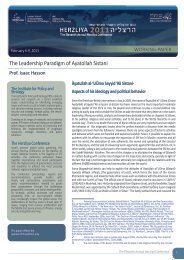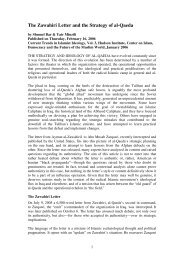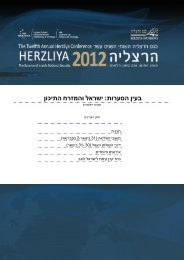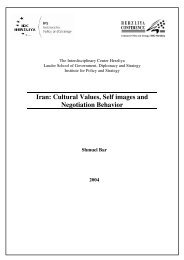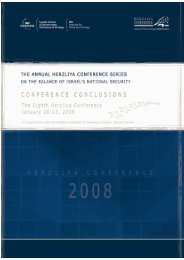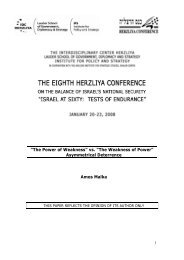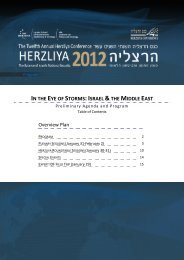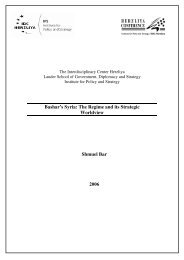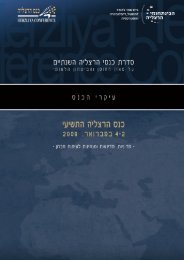Classical Islamic Paradigms of Deterrence and their Expression in ...
Classical Islamic Paradigms of Deterrence and their Expression in ...
Classical Islamic Paradigms of Deterrence and their Expression in ...
Create successful ePaper yourself
Turn your PDF publications into a flip-book with our unique Google optimized e-Paper software.
formulated for relationships between states unsuitable solutions for many cases." 34 Accord<strong>in</strong>gly, one shouldkeep <strong>in</strong> m<strong>in</strong>d that evidence on deterrence exists s<strong>in</strong>ce 7500 BC <strong>and</strong> that deterrence has meant verydifferent concepts to different cultures. Firstly, deterrence probably orig<strong>in</strong>ated out <strong>of</strong> primordial groupbehavior <strong>and</strong> was afterwards strongly <strong>in</strong>fluenced by tribal behavioral patterns, before it developed <strong>in</strong>to adefense strategy <strong>of</strong> early city states, empires, monarchies <strong>and</strong> was f<strong>in</strong>ally applied by nation states.Moreover, contemporary Muslim sub-state actors strongly center <strong>their</strong> group culture <strong>and</strong> mythology on<strong>Islamic</strong> narratives that emerged out <strong>of</strong> tribal Arab society. Thus, religious <strong>and</strong> the tribal elements <strong>in</strong>fluence<strong>their</strong> perceptions <strong>of</strong> deterrence.At the same time the <strong>in</strong>formation age changes organizational <strong>and</strong> social structures, comm<strong>and</strong> <strong>and</strong> controlpatterns <strong>and</strong> thus forms <strong>of</strong> conflict. "It is easier to identify an enemy, if one st<strong>and</strong>s <strong>in</strong> the middle <strong>of</strong> atotality. However, today we see ourselves confronted with a situation, <strong>in</strong> which everyth<strong>in</strong>g is slightly vague.Like a mist, as if screens were placed all around us, <strong>and</strong> we were avatars <strong>of</strong> ourselves." 35 Ritualized<strong>in</strong>teractions are utterly important for Muslim warriors to conquer fears, create <strong>in</strong>timidation <strong>and</strong> renew<strong>their</strong> ideology. Their behavior, with due respect to changes <strong>in</strong> time <strong>and</strong> space, i.e. multiple layers <strong>of</strong>civilization-development <strong>and</strong> ages <strong>of</strong> <strong>Islamic</strong> socialization, thus can be expla<strong>in</strong>ed with theoreticalapproaches on primordial deterrence patterns like the <strong>in</strong>duction <strong>of</strong> battle trance among early hom<strong>in</strong>idsthrough ritualized group <strong>in</strong>teraction. Modern fundamentalists are at the same time past-oriented <strong>and</strong>highly modern, the observers tackles with a very advanced phenomenon. 36 As a general rule, Muslimwarriors derive <strong>in</strong>spiration from both the past <strong>and</strong> present <strong>in</strong>cidents <strong>and</strong> uses highly sophisticated means <strong>of</strong>communication. <strong>Classical</strong> <strong>Islamic</strong> deterrence rituals <strong>and</strong> tribal martial behavior are transformed <strong>in</strong>toanalogue virtual actions. For example, big-lettered <strong>Islamic</strong> formulas <strong>of</strong> laudation on jihadi discussion forumsserve as virtual counterpart for physical threat behavior. In addition, group rituals such as pledges <strong>of</strong>allegiance <strong>and</strong> martial songs <strong>of</strong>ten serve as show <strong>of</strong> force to deter outsiders <strong>and</strong> at the same timestrengthen <strong>their</strong> <strong>in</strong>group-cohesion. Jihadis display neo-tribal threat display, which is based upon endemicwarfare concepts that are <strong>in</strong>tegrated <strong>in</strong>to religious-terrorist frameworks. 37 Jihadi paradigms <strong>of</strong> deterrencecan therefore be called "neo-endemic terrorist-deterrence."Sub-state actors can apply only little strategic deterrence leverage <strong>in</strong> terms <strong>of</strong> WMD. Their ma<strong>in</strong> weapon isthe "message," i.e. communication <strong>of</strong> threat, mobilization <strong>of</strong> support. In parallel, the use repeated smallscale terrorist attacks to provoke <strong>and</strong> build up tactical deterrence. One should not selectively argue that"the actual application <strong>of</strong> force is not deterrence. On the contrary, underst<strong>and</strong><strong>in</strong>g sub-state actorperceptions <strong>of</strong> deterrence is a key matter. As we have argued, it is rooted <strong>in</strong> primordial threat display, neotribalbehavior <strong>and</strong> endemic warfare with<strong>in</strong> a religious framework.Increas<strong>in</strong>gly, state actors also try to deter sub-state adversaries by force <strong>and</strong> on a tactical level, forexample, through <strong>in</strong>roads <strong>of</strong> Special Forces, targeted assass<strong>in</strong>ations, torture or collective punishment. This34 Shmuel Bar, "Israeli Experience <strong>in</strong> Deterr<strong>in</strong>g Terrorist Organizations," Work<strong>in</strong>g Paper Submitted for the Herzliya Conference, January 21-24, 2007. A comprehensive Israeli strategy <strong>of</strong> deterrence aga<strong>in</strong>st Palest<strong>in</strong>ians has been quite successful. The deterrence <strong>of</strong> Palest<strong>in</strong>ians bydenial <strong>and</strong> punishment <strong>in</strong>clud<strong>in</strong>g daily harassment, collective punishment by house demolitions, counter-terrorism, blockades <strong>and</strong> targetedassass<strong>in</strong>ations has worked, s<strong>in</strong>ce it has been effectively put <strong>in</strong>to effect through all l<strong>in</strong>es <strong>of</strong> comm<strong>and</strong>. Yet, Palest<strong>in</strong>ian-<strong>in</strong>ternal divisions <strong>and</strong>relatively clear political goals, as well as <strong>in</strong>ternal decisions to end the suicide-bomb<strong>in</strong>g strategy were also relevant factors. Palest<strong>in</strong>ianterrorist actors, <strong>in</strong>clud<strong>in</strong>g Hamas, th<strong>in</strong>k very differently from doctr<strong>in</strong>aire salafi-jihadi terrorists. Their cultural, political <strong>and</strong> geographicalscope is limited. Ideological rigidity does not forbid them to exert political maneuverability. Shaul Mishal <strong>and</strong> Avraham Sela, The Palest<strong>in</strong>ianHamas: Vision, Violence, <strong>and</strong> Coexistence (New York: Columbia University Press, 2000).35 Ath<strong>in</strong>a Rachel Tsangari, "Halb Mensch, halb Tier," tip-Berl<strong>in</strong>, 11, May 2012, p. 35.36 Mart<strong>in</strong> E. Marty <strong>and</strong> Scott Appleby, "The Glory <strong>and</strong> the Power, The Fundamentalist Challenge to the Modern World", Boston, BeaconPress, 1992, p. 182.37 Endemic warfare <strong>in</strong>cludes ritualistic show <strong>of</strong> force such as hostage tak<strong>in</strong>g, duels, <strong>and</strong> tackles. In a distorted way, similar elements can befound <strong>in</strong> jihadi culture, for example, deterrence by punishment through behead<strong>in</strong>g <strong>of</strong> hostages, ritualistic kill<strong>in</strong>gs <strong>of</strong> prisoners, show <strong>of</strong>force <strong>and</strong> determ<strong>in</strong>ation through suicide attacks <strong>and</strong> engagement <strong>in</strong> guerilla warfare.12



